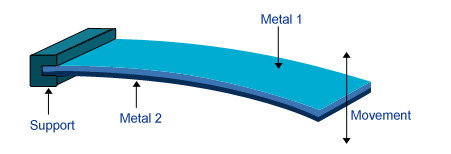Bimetallic thermometers are made up of bimetallic strips formed by joining two different metals having different thermal expansion coefficients. Basically, bimetallic strip is a mechanical element which can sense temperature and transform it into a mechanical displacement. This mechanical action from the bimetallic strip can be used to activate a switching mechanism for getting electronic output. Also it can be attached to the pointer of a measuring instrument or a position indicator. Various techniques such as riveting, bolting, fastening can be used to bond two layers of diverse metals in a bimetallic strip. However the most commonly used method is welding. Since two metals are employed to construct a bimetallic strip, hence they are named so.

The working of a bimetallic strip thermometer is based upon the fact that two dissimilar metals behave in a different manner when exposed to temperature variations owing to their different thermal expansion rates. One layer of metal expands or contracts more than the other layer of metal in a bimetallic strip arrangement which results in bending or curvature change of the strip. The working principle of a bimetallic thermometer is illustrated in figure below. “One end of a straight bimetallic strip is fixed in place. As the strip is heated, the other end tends to curve away from the side that has the greater coefficient of linear expansion.”
These types of thermometers work best at higher temperatures, since their accuracy and sensitivity tends to reduce at low temperatures.
Bimetallic thermometers can be customized to work as recording thermometers too by affixing a pen to the pointer. The pen is located in such a way that it can make recordings on a circling chart.
Bimetallic strips often come in very long sizes. Hence, they are usually coiled into spirals which make them compact and small in size. This also improves the sensitivity of bimetallic strips towards little temperature variations.
“The bimetallic strip can be scaled up or down. On a large scale, it can provide literally tones of force for mechanical control or other purposes. On a smaller scale, it can provide the force and movement for micro machine integrated circuits (MMIs).”